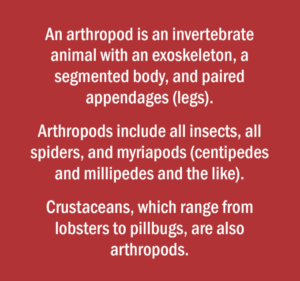By Nadia Ruffin
This article was first posted in The Dirt on Organic Gardening Magazine and is reprinted with the permission of the author.
The trees are starting to lose their leaves, squirrels are gathering nuts, and the birds are starting to migrate. You feel a coolness in the air.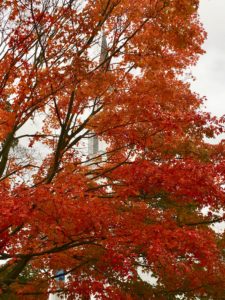
Yes, it’s coming—the fall and winter seasons. Those plants in your container gardens are not adapted to a cold climate, so it’s time to move those plants indoors before the first frost wipes them out.
You diligently position your pots and containers next to your west and south-facing windows so they can get their share of winter sunlight. Everything is fine—for a few weeks.
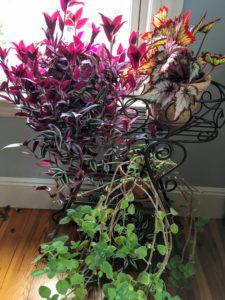
Then you notice a few leaves falling off your plants. You don’t think anything of it at first, but then your vibrant plants start to go downhill fast.
You do a careful inspection and you find that your plants are infested with insects!
Be Informed and Be Ready
Having plants indoors does not prevent you from having insects, so don’t let trouble follow you indoors. Always check your plants before you bring them inside. Start by examining leaves. Look at both the upper and lower surfaces. Next, check the stems, then inspect the soil. Look for eggs, cocoons, adults, nymphs, and larvae. If you find anything, try to identify what it is before you treat the plant. Remove by hand what you do find, then choose the correct method of control.
For example, if you find caterpillars, use Bacillus thuringiensis (Bt for short—a substance non-toxic to pretty much anything except caterpillars) instead of a homemade oil or soap spray, which will not be nearly as effective.
After treating your plants, wait about a week, then treat again. This gives time for eggs to hatch that you may not have spotted while performing your visual inspection.
If you find insects or other arthropods in the soil, you may want to re-pot the plants. Insect populations indoors can quickly skyrocket out of control because natural enemies and other environmental factors are no longer suppressing their populations.
With that said, you should know that your plant can also be home to natural enemies and other beneficial insects, so it’s important to know what they look like so you can relocate them back outdoors.
Four Common Arthropods Found on Overwintering Plants
Whiteflies
Whiteflies are very small, about a tenth to a sixteenth of an inch long, and resemble tiny white moths when they fly.
The first indication you have a whitefly issue is that the leaves on your plants will start to brown. Pretty much 99.9% of the time whiteflies can be found on the underside of the leaves. They are active during the day when the temperature is warm. If you walk past a plant with a heavy infestation and disturb them, you will see a white cloud of what looks like dust flying in the air, but is the winged adult whiteflies.
Damage
Common signs of a whitefly infestation are stunted plant growth, yellowed foliage that eventually turns brown and crunchy, and premature leaf drop. Since whiteflies normally suck out more sap than they can digest, they excrete sticky honeydew during feeding. This honeydew allows gray sooty mold fungi to grow on the foliage.
Management
Prevention is the best management. This can be done by quarantining new plants and inspecting them for whiteflies before placing them in your home.
Whitefly adults are attracted to the color yellow. You can use commercial or homemade sticky traps (these are usually yellow). The use of traps is most effective indoors or in greenhouses. The best method to control nymphs and eggs is to smother them using an oil and castile soap spray that you can easily make at home.
If you find a plant to be heavily infested with whiteflies, you may want to get rid of it entirely. For the soap solution to be at all effective on adults, it is best to spray the plants when the adults are not active, at night or when temperatures are cool. Make sure you spray the undersides of the leaves as well as the tops.
Spider Mites
Spider mites are not actually insects but are arachnids, like spiders and ticks. They have eight legs and spin webs on the undersides of leaves. They are hard to see with the naked eye, but if you do encounter them, they look like moving dots on the leaves.
There are numerous species of spider mites, but the most common ones found on indoor plants are two-spotted spider mites and red spider mites.
Damage
Spider mites are sap feeders. They use their piercing-sucking mouthparts to suck the sap out of leaves, and the leaves will have spots where they have been feeding. The leaves will start to look disfigured, brown, wilted, or may even curl. If the plant is heavily infested, it may start to defoliate (loose leaves).
Management
Inspect the undersides of the leaves for webbing, as this is the most obvious sign. To see the actual mites you may require a magnifying glass. Also, you can take a white piece of paper and place it under a leaf and tap it. If you see tiny dark specks moving on the paper you have spider mites.
You can get an infestation under control by using castile soap and water in a spray bottle. Spray both sides of the leaves, then take a sponge or paper towel to both the upper and lower surfaces of the leaves. If you are squeamish about wiping the leaves, you can just spray the water/soap mixture and the solution will eventually kill the mites.
Repeat this process within a week, and continue to repeat until you no longer see any signs of the spider mites.
Aphids
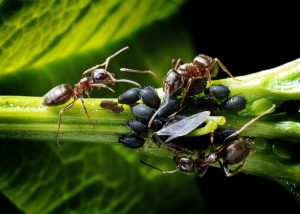
Ants having a tasty aphid snack.
Aphids are very small (about one thirty-second to one-eighth of an inch), pear-shaped insects with two tube-like structures at the end of their bodies. They come in a variety of colors—green, yellow, red, gray, and more.
Adults will develop wings and relocate to other plants if resources become depleted. Aphids usually feed in huge numbers with both adults and nymphs feeding on the same plant.
Damage
Aphids are sap feeders. Using their piercing-sucking mouthparts, they suck the sap out of leaves, stems, buds, flowers, and even roots. Look for yellow, disfigured, or curled leaves. Also, look for honeydew on leaves.
Management
Aphids can be controlled with a castile soap/oil spray or just neem oil. Both of these will smother the adults and nymphs. Before you bring plants inside, a quick spray with the garden hose will remove a large number of aphids. Still, inspect the plant after spraying then treat with your soap spray. Repeat treatments every 7–10 days until you do not see any more adults.
Fungus gnats
These are small flies that infest soil, compost, and other decomposing organic matter. The larvae are the stage of these insects that do the damage. Adults do not feed, but the larvae feed on fungus, decomposing organic material, and plant roots. Fungus gnats are not fruit flies.
Damage
Stunted or slow growth is the first indication of larvae feeding. If you do not get the infestation under control quickly, your plants can be killed—especially young seedlings and immature plants.
Management
First, check the soil for larvae. You may even want to repot the plants, especially if you’ve had issues with fungus flies in the past.
Adults can be controlled with yellow sticky traps. To kill larvae, reduce watering your plants as often and allow the soil to dry out before watering again. Also, reduce organic matter in the pots. Never move infested plants into an area free of fungus gnats. The plants already there will surely become infested.
The Good Guys
Some common beneficial insects that are brought indoors are lady beetles and their larvae, praying mantid egg cases, spiders, parasitic wasp cocoons, and centipedes. While these insects are your friends, it doesn’t mean you want to keep them indoors with you. Instead, whenever possible, remove them from your plants and relocate them outdoors.
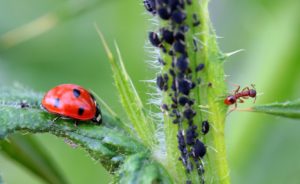
Lady beetle enjoying aphids for lunch.
Conclusion
When relocating plants indoors for the winter, it is very important that you inspect them for unwanted guests. If you find some, it is important to know what you are dealing with so you can treat the issue accordingly.
Failing to inspect your plants before bringing them in increases the likelihood that you’ll end up playing host to creatures you’d rather not entertain!
If you do not there will surely be problems for your plants.
About the Author
Nadia Ruffin is an entomologist, gardener, and educator and holds degrees in Agriculture and in Entomology. She is the founder of Agricademy Inc, Quiwi Produce, and Urban Farm Sista based in Cincinnati, Ohio. In addition to farming and research, Nadia’s mission is to bring together and educate urban and rural communities to share her knowledge and passion for the biological world and to instill curiosity as she connects youth and adults to the wonders of healthy food and nature’s beauty. Nadia is also an author and has published articles for The Dirt on Organic Gardening and for Rodale publications. In 2018, a resolution from Cincinnati City Council honored Nadia’s farming practices, agriculture initiatives, and community outreach.
***
Each author appearing herein retains original copyright. Right to reproduce or disseminate all material herein, including to Columbia University Library’s CAUSEWAY Project, is otherwise reserved by ELA. Please contact ELA for permission to reprint.
Mention of products is not intended to constitute endorsement. Opinions expressed in this newsletter article do not necessarily represent those of ELA’s directors, staff, or members.

